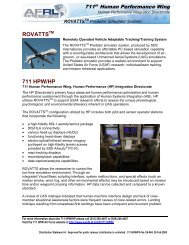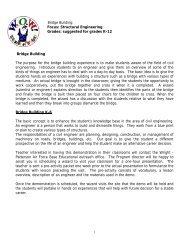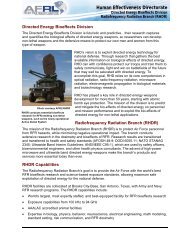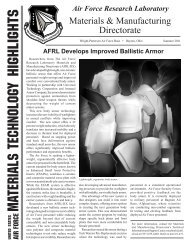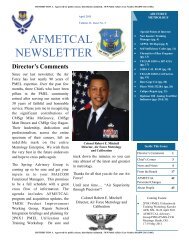Plant 44 Audit Reports - Wright-Patterson Air Force Base
Plant 44 Audit Reports - Wright-Patterson Air Force Base
Plant 44 Audit Reports - Wright-Patterson Air Force Base
- No tags were found...
You also want an ePaper? Increase the reach of your titles
YUMPU automatically turns print PDFs into web optimized ePapers that Google loves.
FOR OFFICIAL USE ONLYDistribution authorized to DoD components and their contractors only; administrative/operational use;August 19,2005. Other requests for this document shall be referred to the Chief, AcquisitionEnvironmental Safety & Health Division, Engineering Directorate, ASC/ENV, <strong>Wright</strong> <strong>Patterson</strong> <strong>Air</strong><strong>Force</strong> <strong>Base</strong>, OH 454333.1.4. Mutual Aid. The Fire Officers were counting on several fire ground duties, operations and supportto be performed by outside fire companies during the early stages ofthe incident. The IC adjustedwell without them during the initial attack with their limited staffing. Once the mutual aid supportshowed at the gates, the security escort and coordination with the fire department IC was wellexecuted.3.] .5. Radio communication and the switch to the emergency frequency were well demonstrated.However, communication inside the building was degraded which jeopardizes the safety ofthefirefighters.3.1.6. Hose Advancement: The appropriate fire hydrant was used to supply the first Engine. However,the crews delayed the pulling ofthe pre-connect hose lines. When the crews attempted to pull thehose down to the basement the hose tangled and there were not enough firefighters (FFs) availableto assist. There was also a delay in charging the line. Once in the basement, the crews haddifficulties advancing the line due to the line was charged and tangled outside the building. Aftera short advance toward the simulated fire and victim, one FF ran short on air and had to withdraw.This action required both FFs to exit the building. Instead of laying the nozzle down they delayedtheir exit by attempting to remove the hose back to the exit instead of following the hose out.However, they did exit as a team instead of separating. In tum, by not laying the hose downdelayed the replacement crews in fire fighting efforts and rescue attempt. The second crew wasnot briefed by the first crew as to the process already accomplished. The crews also failed to takeappropriate equipment with them on the initial attack i.e., the thermal imaging device which wouldhave enhanced their probability of finding the fire and victim. (Action required)3.1.7. Incident Management System: The IC set up in an ideal location and had complete vision oftheoperations. Although a checklist was not used, the IC demonstrated total knowledge of hisresponsibilities and duties. His command and control abilities were well performed. Thesupporting personnel, i.e., security, maintenance, etc reported to the IC and all were gathered in asafe area away from danger. The communications between the operation commander and handline personnel were weak. The first crews to arrive fai led to report their observation of the sceneimmediately to dispatch and the IC after an input card was provided. The OpslC was over tasktrying to perform duties ofthe OpslC and Safety Officer. FFs were entering the basement withoutaccountability and reporting to or being directed by the OpsIC. As a result, the fire suppressionand rescue operation was being performed in an unsafe manner and the objectives ofsaving a lifeand extinguishing the fire was not met. Once it was determined the fire could not be extinguishand the victim could not be rescued, the IC immediately placed his crew in a defense mode which,unfortunately, was the proper call. Recommendation: Provide more FFs on the fire groundslAW NFPA ]710. (Action required)3.1.8. Immediate Danger to Life and Health (IDLH): The IDLH was not declared. This made it unclearas to where to set up the Accountability person and where FFs were required to be 'on-air' andwhere the Rapid Intervention Team (RIT) and Rehab area were to be formed. Recommendation:Conduct more exercises. Ensure all fire operations are lAW local standards and procedures andmeet all the National Standards as required. Procedures shall be in place to identify the IDLH areaIAW NFPA ]500 for all exercises and emergency responses involving fire and/or Hazmatincidents plus broadcasting as required. Ref: OSHA 191 0.134(g), NFPA ]500, par. 5-3,6-4.(Action required)3.1.9. Rehab: The rehab vehicle and equipment was set up as directed by the IC in a safe area awayfrom immediate danger. However, with limited staffing, it was not always manned. When FFswere directed to go the rehab. the EMT/paramedic was not equipped with necessarytools/equipment i.e., a watch with a sweep hand to take vitals, etc. By not having the requirednumber of FFs on scene, FFs are performing prolong duties without proper rehab.Recommendation: Follow the Raytheon medical department's recommendation as to whatequipment is necessary for the safe being of FF on scene to ensure proper rehab and care.3.1.10. Safety Officer: Department is not properly staff to assign a Safety Officer at an emergencyincident. The Safety Officer was not readily identified by a vest or the like. He did not ensure thatATCH2




